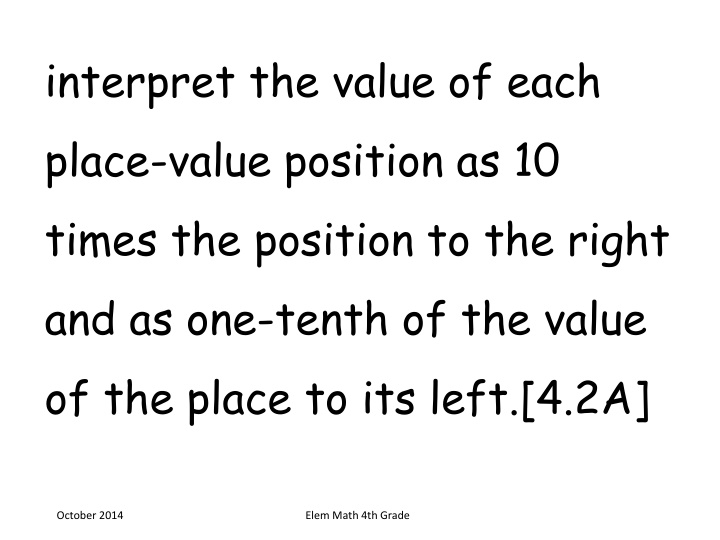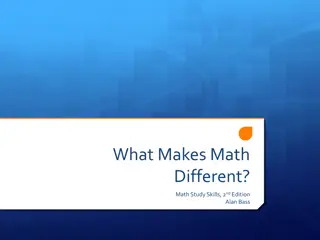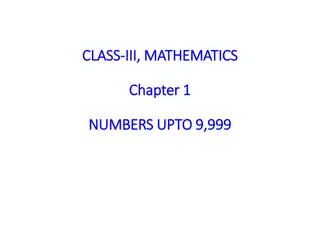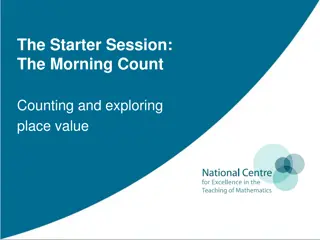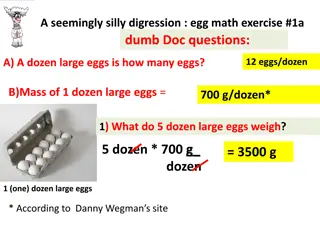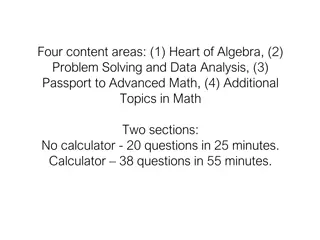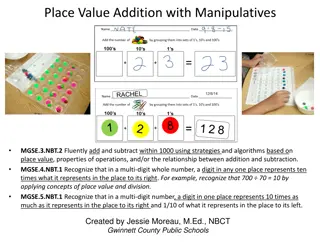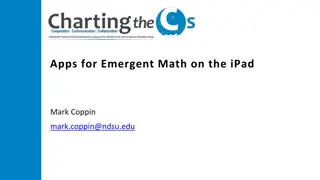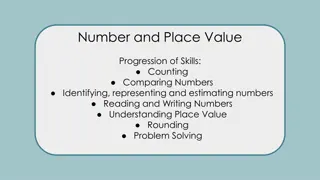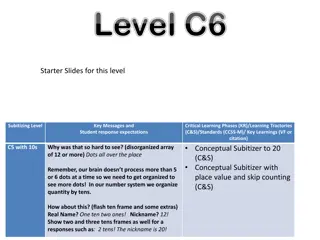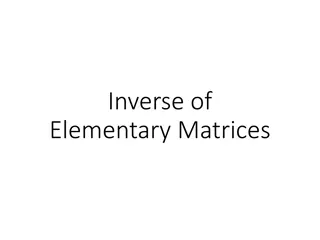Place Value Interpretation and Comparison in Elementary Math
Dive into the world of place value in elementary math with topics ranging from interpreting the value of each place in numbers and decimals to comparing and ordering whole numbers and decimals. Explore concepts like rounding, representing decimals using models, relating decimals to fractions, and more. Get a comprehensive understanding of how to represent and work with numbers in expanded notation, numerals, and visual models.
Download Presentation

Please find below an Image/Link to download the presentation.
The content on the website is provided AS IS for your information and personal use only. It may not be sold, licensed, or shared on other websites without obtaining consent from the author.If you encounter any issues during the download, it is possible that the publisher has removed the file from their server.
You are allowed to download the files provided on this website for personal or commercial use, subject to the condition that they are used lawfully. All files are the property of their respective owners.
The content on the website is provided AS IS for your information and personal use only. It may not be sold, licensed, or shared on other websites without obtaining consent from the author.
E N D
Presentation Transcript
interpret the value of each place-value position as 10 times the position to the right and as one-tenth of the value of the place to its left.[4.2A] October 2014 Elem Math 4th Grade
represent the value of the digit in whole numbers through 1,000,000,000 and decimals to the hundredths using expanded notation and numerals.[4.2B] October 2014 Elem Math 4th Grade
compare and order whole numbers to 1,000,000,000 and represent comparisons using the symbols >, <, or =.[4.2C] October 2014 Elem Math 4th Grade
round whole numbers to a given place value through the hundred thousands place. [4.2D] October 2014 Elem Math 4th Grade
represent decimals, including tenths and hundredths, using concrete and visual models and money.[4.2E] October 2014 Elem Math 4th Grade
compare and order decimals using concrete and visual models to the hundredths. [4.2F] October 2014 Elem Math 4th Grade
relate decimals to fractions that name tenths and hundredths.[4.2G] October 2014 Elem Math 4th Grade
determine the corresponding decimal to the tenths or hundredths place of a specified point on a number line.[4.2H] October 2014 Elem Math 4th Grade
represent a fraction a /b as a sum of fractions 1/b, where a and b are whole numbers and b > 0, including when a > b. [4.3A] October 2014 Elem Math 4th Grade
decompose a fraction in more than one way into a sum of fractions with the same denominator using concrete and pictorial models and recording results with symbolic representations.[4.3B] October 2014 Elem Math 4th Grade
determine if two given fractions are equivalent using a variety of methods.[4.3C] October 2014 Elem Math 4th Grade
compare two fractions with different numerators and different denominators and represent the comparison using the symbols >, =, or <. [4.3D] October 2014 Elem Math 4th Grade
represent and solve addition and subtraction of fractions with equal denominators using objects and pictorial models that build to the number line and properties of operations.[4.3E] October 2014 Elem Math 4th Grade
evaluate the reasonableness of sums and differences of fractions using benchmark fractions 0, 1/4, 1/2, 3/4, and 1, referring to the same whole. [4.3F] October 2014 Elem Math 4th Grade
represent fractions and decimals to the tenths or hundredths as distances from zero on a number line.[4.3G] October 2014 Elem Math 4th Grade
add and subtract whole numbers and decimals to the hundredths place using the standard algorithm.[4.4A] October 2014 Elem Math 4th Grade
determine products of a number and 10 or 100 using properties of operations and place value understandings. [4.4B] October 2014 Elem Math 4th Grade
represent the product of 2 two-digit numbers using arrays, area models, or equations, including perfect squares through 15 by 15. [4.4C] October 2014 Elem Math 4th Grade
use strategies and algorithms, including the standard algorithm, to multiply up to a four-digit number by a one-digit number and to multiply a two-digit number by a two-digit number. Strategies may include mental math, partial products, and the commutative, associative, and distributive properties.[4.4D] October 2014 Elem Math 4th Grade
represent the quotient of up to a four-digit whole number divided by a one-digit whole number using arrays, area models, or equations.[4.4E] October 2014 Elem Math 4th Grade
use strategies and algorithms, including the standard algorithm, to divide up to a four-digit dividend by a one- digit divisor.[4.4F] October 2014 Elem Math 4th Grade
round to the nearest 10, 100, or 1,000 or use compatible numbers to estimate solutions involving whole numbers.[4.4G] October 2014 Elem Math 4th Grade
solve with fluency one- and two-step problems involving multiplication and division, including interpreting remainders.[4.4H] October 2014 Elem Math 4th Grade
represent multi-step problems involving the four operations with whole numbers using strip diagrams and equations with a letter standing for the unknown quantity.[4.5A] October 2014 Elem Math 4th Grade
represent problems using an input- output table and numerical expressions to generate a number pattern that follows a given rule representing the relationship of the values in the resulting sequence and their position in the sequence.[4.5B] October 2014 Elem Math 4th Grade
use models to determine the formulas for the perimeter of a rectangle (l + w + l + w or 2l + 2w), including the special form for perimeter of a square (4s) and the area of a rectangle (l x w).[4.5C] October 2014 Elem Math 4th Grade
solve problems related to perimeter and area of rectangles where dimensions are whole numbers.[4.5D] October 2014 Elem Math 4th Grade
identify points, lines, line segments, rays, angles, and perpendicular and parallel lines.[4.6A] October 2014 Elem Math 4th Grade
identify and draw one or more lines of symmetry, if they exist, for a two-dimensional figure.[4.6B] October 2014 Elem Math 4th Grade
apply knowledge of right angles to identify acute, right, and obtuse triangles.[4.6C] October 2014 Elem Math 4th Grade
classify two-dimensional figures based on the presence or absence of parallel or perpendicular lines or the presence or absence of angles of a specified size.[4.6D] October 2014 Elem Math 4th Grade
illustrate the measure of an angle as the part of a circle whose center is at the vertex of the angle that is "cut out" by the rays of the angle. Angle measures are limited to whole numbers.[4.7A] October 2014 Elem Math 4th Grade
illustrate degrees as the units used to measure an angle, where 1/360 of any circle is one degree and an angle that "cuts" n /360 out of any circle whose center is at the angle's vertex has a measure of n degrees. Angle measures are limited to whole numbers.[4.7B] October 2014 Elem Math 4th Grade
determine the approximate measures of angles in degrees to the nearest whole number using a protractor.[4.7C] October 2014 Elem Math 4th Grade
raw an angle with a given measure.[4.7D] October 2014 Elem Math 4th Grade
determine the measure of an unknown angle formed by two non-overlapping adjacent angles given one or both angle measures.[4.7E] October 2014 Elem Math 4th Grade
identify relative sizes of measurement units within the customary and metric systems.[4.8A] October 2014 Elem Math 4th Grade
convert measurements within the same measurement system, customary or metric, from a smaller unit into a larger unit or a larger unit into a smaller unit when given other equivalent measures represented in a table.[4.8B] October 2014 Elem Math 4th Grade
solve problems that deal with measurements of length, intervals of time, liquid volumes, mass, and money using addition, subtraction, multiplication, or division as appropriate.[4.8C] October 2014 Elem Math 4th Grade
represent data on a frequency table, dot plot, or stem-and- leaf plot marked with whole numbers and fractions.[4.9A] October 2014 Elem Math 4th Grade
solve one- and two-step problems using data in whole number, decimal, and fraction form in a frequency table, dot plot, or stem-and-leaf plot. [4.9B] October 2014 Elem Math 4th Grade
distinguish between fixed and variable expenses.[4.10A] October 2014 Elem Math 4th Grade
calculate profit in a given situation.[4.10B] October 2014 Elem Math 4th Grade
compare the advantages and disadvantages of various savings options.[4.10C] October 2014 Elem Math 4th Grade
describe how to allocate a weekly allowance among spending; saving, including for college, and sharing.[4.10D] October 2014 Elem Math 4th Grade
describe the basic purpose of financial institutions, including keeping money safe, borrowing money, and lending.[4.10E] October 2014 Elem Math 4th Grade
solve for products of decimals to the hundredths, including situations involving money, using strategies based on place-value understandings, properties of operations, and the relationship to the multiplication of whole numbers.[5.3E] October 2014 Elem Math 4th Grade
represent and solve addition and subtraction of fractions with unequal denominators referring to the same whole using objects and pictorial models and properties of operations.[5.3H] October 2014 Elem Math 4th Grade
add and subtract positive rational numbers fluently. [5.3K] October 2014 Elem Math 4th Grade
describe the key attributes of the coordinate plane, including perpendicular number lines (axes) where the intersection (origin) of the two lines coincides with zero on each number line and the given point (0, 0); the x-coordinate, the first number in an ordered pair, indicates movement parallel to the x-axis starting at the origin; and the y-coordinate, the second number, indicates movement parallel to the y- axis starting at the origin.[5.8A] October 2014 Elem Math 4th Grade
